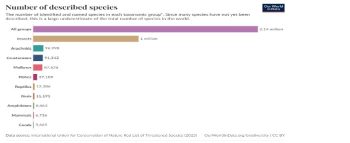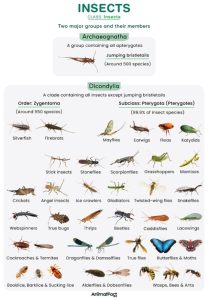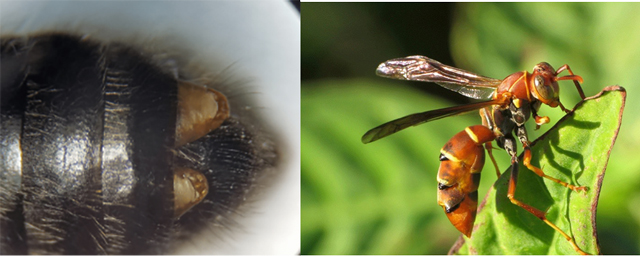By Vidya Rajan, Columnist, The Times
 Beekeepers need no homily on the awesomeness of insects, nor do picknickers need one on the annoyance of midges, mosquitoes and ants and yellowjackets. These well-known insects make up only a small fraction known insects. To put numbers in context, a figure compiled by the International Union for Conservation of Nature Red List of Threatened Species lists numbers of species in various animal classes (Figure 1). Of 2.14 million catalogued animal species, 1.2 million are arthropods (insects + arachnids + crustaceans). Of these, 1 million are insects (springtails, wasps, ants, bees, moths, butterflies, dragonflies, mayflies, true flies and beetles). Within insects, 40% – a remarkable 400,000 species – are beetles. Biologist, polymath and atheist J. B. S. Haldane[1] is reputed to have said, “If one could conclude as to the nature of the Creator from a study of creation it would appear that God has an inordinate fondness for stars and beetles.
Beekeepers need no homily on the awesomeness of insects, nor do picknickers need one on the annoyance of midges, mosquitoes and ants and yellowjackets. These well-known insects make up only a small fraction known insects. To put numbers in context, a figure compiled by the International Union for Conservation of Nature Red List of Threatened Species lists numbers of species in various animal classes (Figure 1). Of 2.14 million catalogued animal species, 1.2 million are arthropods (insects + arachnids + crustaceans). Of these, 1 million are insects (springtails, wasps, ants, bees, moths, butterflies, dragonflies, mayflies, true flies and beetles). Within insects, 40% – a remarkable 400,000 species – are beetles. Biologist, polymath and atheist J. B. S. Haldane[1] is reputed to have said, “If one could conclude as to the nature of the Creator from a study of creation it would appear that God has an inordinate fondness for stars and beetles.

Figure 1: Described species of animals by number. From: https://ourworldindata.org/how-many-species-are-there
reproduced under CC BY attribution license.
But there is an underbelly to the proliferation of insects which occupy pretty much every niche, except on the continent of Antarctica which hosts only one native insect, a flightless midge called Belgica antarctica.[2] Their spread and numbers are such that they cannot easily get away from each other, and, by that hangs an eerie tale of body-snatchers and zombies. In homage to Halloween and spookiness in general, in this article, I will focus on insects that parasitize other insects during some part of their life cycle, leading to the eventual death of the host. Such insects are called parasitoids.[3]
But, first, a little background to insects and their development. Despite the enormous diversity of insects, all have six legs, and all lay eggs (Figure 2). They take one of two paths when the eggs hatch: as ‘ametabolous’ or fully developed miniature adults (subclass Archeognatha) which do not undergo any metamorphosis. These insects are termed ‘apterygotes’ and include order Zygentoma, lack wings and undergo molting to achieve size increases. The other group is made up of metabolous insects (subclass Dicondylia) with ‘pterygotes’ that undergo either incomplete or complete metamorphosis. Incomplete metamorphosis results in eggs hatching into miniature forms called nymphs, but these insects (e.g. cockroaches, grasshoppers, termites, praying[4] mantises and lice) have wings and molt several times to achieve adult size with mature wings. Complete metamorphosis occurs in many familiar insects, such as bees and butterflies, which develop through wingless larval, encased pupal, and winged adult stages. Since insects do not lay large eggs containing food, the larva hatch out quickly and have to eat to grow. Thus, they have to be continuously fed as they develop, such as honeybees; be provided nutrition on a secluded food source, such as a pollen ball in bumblebees; or the larva has to find forage and feed itself independently, such as leaf-eating caterpillars of moths and butterflies. If it acquires sufficient nutrition, the larva molts through several stages called ‘instars’, pupates, and emerges as an adult.

Figure 2: Insect diversity. From: https://animalfact.com/insect/. Reproduced under Fair Use.
Parasitoids feed on other insects during some stage of their life cycle. Ichneumon wasps are body snatchers. With their long ovipositor, they lay their eggs inside other insects or larvae, and then carry them to their homes and seal them into a cavity. Another wasp, the emerald cockroach wasp hunts down cockroaches that can be twice its size and injects its venom carefully into a specific location in the host’s brain, which disables the cockroach’s escape reflex. The cockroach grooms extensively as the toxin goes to work. Then the wasp cuts short one of the cockroach’s antenna, and takes a drink of the cockroach’s hemocoel to replenish herself, and leads the now-docile cockroach by its antenna down into its burrow and lays an egg or two on its belly. The eggs hatch a couple of days later and feed on the living flesh of the host and maintain its freshness by saving the vital organs for last. Pupation occurs inside the hollowed-out and, by now, quite dead host’s body.

Figure 3: Wasp ‘walking’ a roach. From: https://en.wikipedia.org/wiki/Emerald_cockroach_wasp
Thread-waisted (sphecid) wasps similarly attack prey that are larger than themselves such as crickets and grasshoppers. The Liris wasp paralyzes a nonfossorial (above-ground living) cricket but drags it into a burrow and seals it in with an egg. The cricket soon revives and walks around but does not attempt to escape. The larva that hatches out of the egg consumes it in a manner similar to the emerald cockroach wasp larva consuming the cockroach. A different type of thread-waisted wasp, the Larra wasp, will beard a burrowing (fossorial) cricket in its den, attacking it so vigorously that the cricket leaves its burrow. Freed from the burrow’s confines, the wasp wrestles with the cricket, stinging it to paralysis and then sucking its hemolymph and laying an egg on its belly. The cricket recovers and heads homes into its burrow, unknowingly carrying the egg with it. When the larva hatches, it sucks the cricket’s hemolymph to grow, pupates and leaves both the burrow and the desiccated and dying cricket.
A twist in the tale is introduced by twisted-wing flies, called Strepsiptera.[5] The males are free-living with raspberry-like eyes and the forewing modified into a club-like structure. Curiously, the males’ eyes resemble those of the extinct trilobite group by having a few dozen ommatidia rather than the compound eyes seen in most insects.[6] Young female strepsipterans seek out hosts in their larval form which is mobile and has six legs. Typically, they crawl onto a plant or flower and wait there until a potential host approaches and burrow into passing hymenoptera (bees and wasps), leafhoppers and cockroaches. Once inside a host, they molt, and lose their legs, eyes and wings and become entirely parasitic. Pupation occurs inside the host and mouthless, short-lived (~5 hours) flying males emerge, but females remain larva-like, and remain inside the host, feeding from its hemolymph and castrating it. They protrude their abdomen from the host’s body for mating with males, whom they summon with pheromones. Mated females release 2,000 to 7,000 larvae which scuttle around until they, too, find a host.[7] Thankfully, they are not too abundant, although there are 84 species in North America.

Figure 3: Strepsipteran larvae protruding from the abdomen of a bee (left), and wasp (right). Bee photo credit: Jessica Hird. https://extension.oregonstate.edu/catalog/strepsiptera-strange-parasite-attacks-bees-other-insects. Wasp photo credit: https://genent.cals.ncsu.edu/insect-identification/order-strepsiptera/
If your bees look moribund, check their butts.
[1]. J. B. S. Haldane (1892-1964) was a British-born scientist and polymath. He did not have a formal academic degree, he pioneered the application of statistics to biology, articulated ‘Haldane’s Rule’ and Haldane’s dilemma, introduced the terms “clone” and “cloning”, described genetic linkage, linked DNA and inheritance thereby ushering in the modern concept of Darwinian evolution and formalizing population statistics. Following the Suez crisis, Haldane rejected British imperialism, renounced his British citizenship, moved to India with his partner, Helen Spurway and became an Indian citizen. He died in Orissa, India, in 1964.
[2]. How a Tiny Insect Outsmarts Antarctica’s Brutal Cold. (2025, February 21). SciTechDaily. https://scitechdaily.com/how-a-tiny-insect-outsmarts-antarcticas-brutal-cold/
[3]. The difference between a parasite and a parasitoid is that a parasite has a long-term relationship with its host, and does not cause its death, whereas a parasitoid exploits the host during one stage of its life, causing its death.
[4]. I prefer the spelling preying mantises as these are excellent hunters, preying on a variety of other insects and even small vertebrates like frogs and mice.
[5]. Kathirithamby, J. (2009). Host-parasitoid associations in Strepsiptera. Annual Review of Entomology, [online] 54, pp.227–249. doi: https://doi.org/10.1146/annurev.ento.54.110807.090525
[6]. Insect Order Strepsiptera – North American Insects & spiders. (2018). Cirrusimage.com. https://www.cirrusimage.com/strepsiptera/
[7]. Order Strepsiptera. (n.d.). ENT 425 – General Entomology. https://genent.cals.ncsu.edu/insect-identification/order-strepsiptera/




